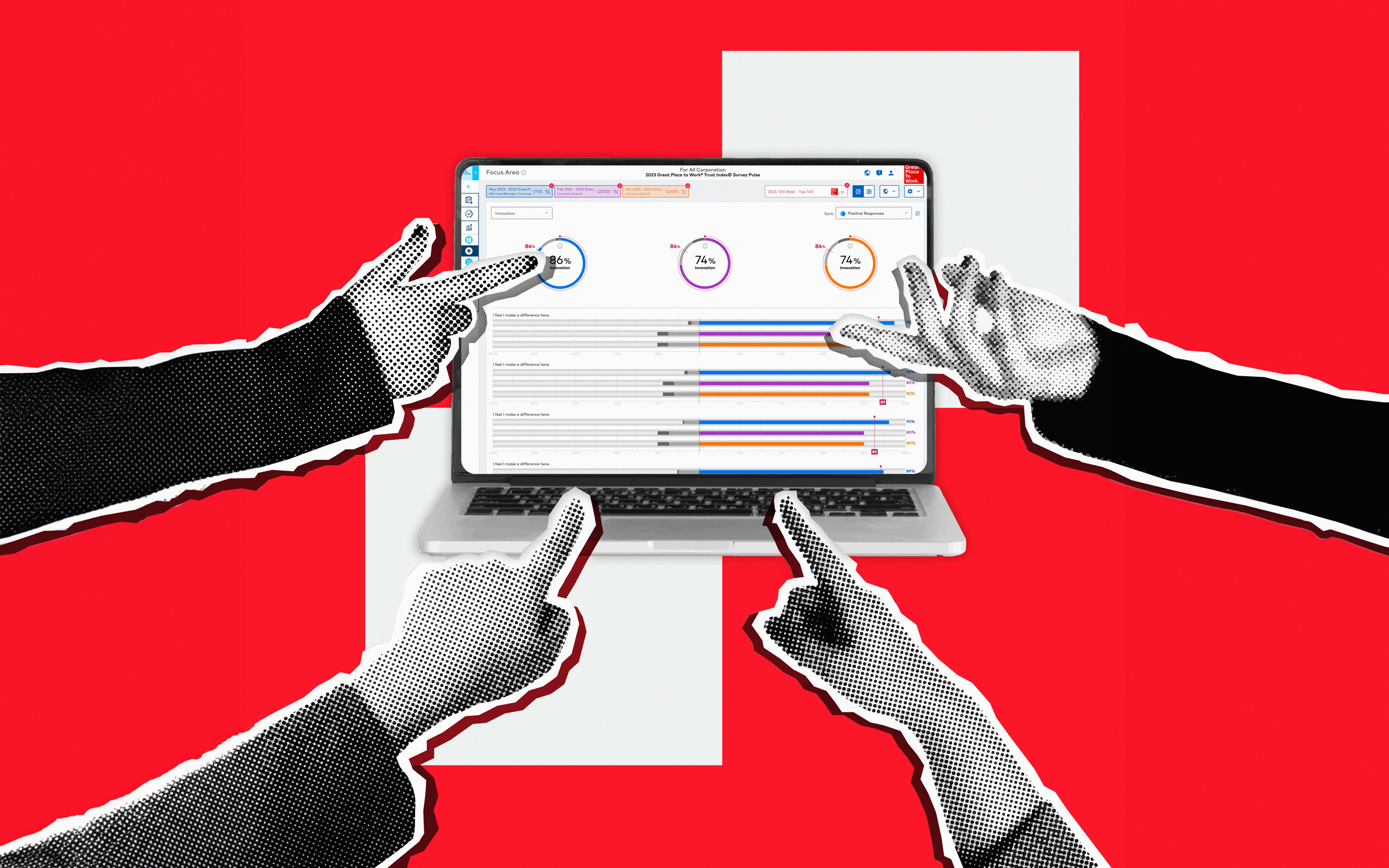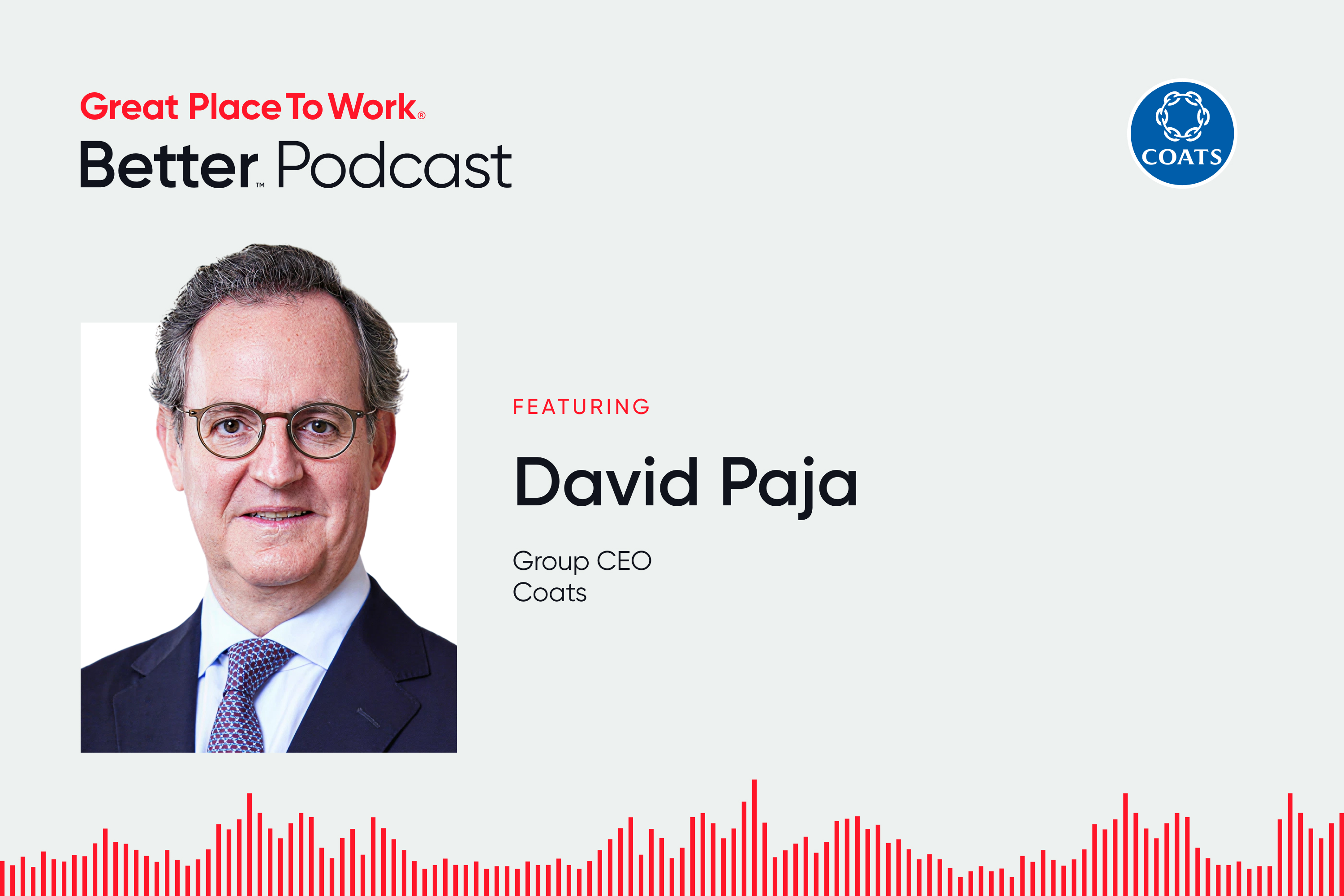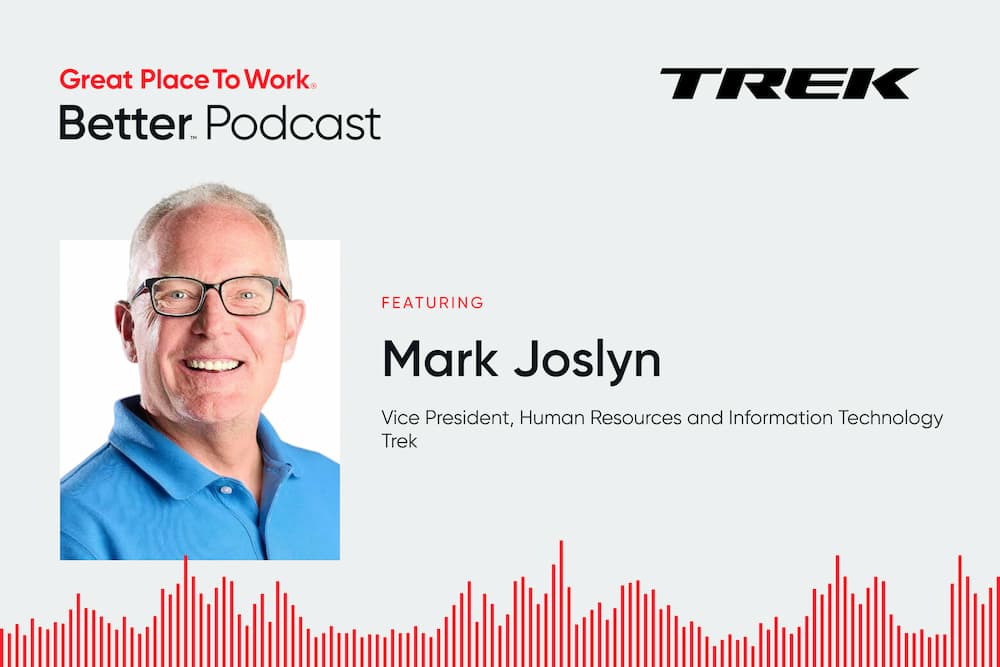Employee Engagement, Employee Experience, Employee Surveys
You can’t respond to employee needs if you don’t know what they are. A powerful way to elicit feedback is a pulse survey.
Building a strong culture means listening to your people. Listening is also one of the nine high-trust behaviors that define business success. Pulse surveys are a powerful tool for listening to your people and gathering real-time employee feedback.
The 2025 Fortune 100 Best Companies to Work For® understand this, and the ROI speaks for itself: The 100 Best Companies have 8.5 times the revenue per employee (RPE) compared to the U.S. public market RPE.
Surveys play a role in creating a responsive, employee-centric workplace culture, one that can drive meaningful business results.
What is a pulse survey and why does it matter?
Key components of effective employee pulse surveys
While there’s no one-size-fits-all approach for conducting pulse surveys, here are some key components of an effective pulse survey plan:
Prep carefully. Look at the results from your annual survey and identify your main growth opportunities. After working through the data, consider launching a pulse survey that focuses on one or two specific areas.
Set a deliberate cadence. There’s no right or wrong timing for pulse surveys, and depending on your business goals, they could be conducted semiannually, quarterly, monthly, or even weekly. Organizations may choose to align the timing of pulse surveys with business cycles and initiatives. For instance, rolling out a pulse survey to better understand how to support employees after a merger or to gauge the onboarding experience of new hires.
Keep surveys short and focused. Keep the number of questions short and specific, compared to an annual survey. The fewer — and more targeted — the questions, the easier it is to home in on actionable feedback. For example, include just three to six questions, so your people know the pulse survey will take a few minutes of their time, as opposed to 15 minutes.
Ensure questions are clear and actionable. Use a mix of both closed-ended questions (e.g. “strongly disagree” to “strongly agree”) to analyze quantifiable data, as well as open-ended questions so employees can add context or expand on their answers.
Open-ended questions are an opportunity for employees to share insights and suggestions that help drive innovation. Maintain consistency in the types of core questions asked, so leaders and HR teams can identify trends.
Act on the results — Leaders have an important role in supporting and growing talent, and pulse surveys are an effective tool for understanding what drives your people. However, it's important to only survey your employees if you know you'll act on their feedback.
A vital component of trust is credibility. Your people want to see that leaders are competent, communicative and honest. Summarize leadership’s key takeaways and commitments to action. Then, clearly communicate with employees the results from new initiatives and programs created because of the survey.
Measuring the impact of pulse surveys
Pulse surveys only work if employees and leaders fully participate in the process. Key metrics for assessing the effectiveness of pulse surveys include:
Response rates. Ideally, organizations want a high response rate to pulse surveys. Unless people are intrinsically motivated to give candid feedback, they may simply be going through the motions. A good rate of participation would be over 50% for a pulse survey. This still provides leaders with enough data to feel confident that the feedback is a fair representation of your workforce.
Trend analysis of key indicators. Surveying your people regularly gives leaders data over time, which can be used to identify trends in employee sentiment. This helps organizations track the effectiveness of new initiatives, such as initiating a four-day workweek model.
Identifying areas for improvement. With data in hand, leaders have a clear road map of any areas of concern or improvement based on employee feedback. By proactively addressing issues, such as employee sentiment on effective leadership, organizations can address issues before they escalate.
Implementation rates for post-survey action plans. Document and evaluate the impact of specific actions taken to address issues raised in the survey. For example, if you implemented a new training program in AI, measure its impact on employee knowledge and skills.
Correlation with business outcomes. Pulse surveys provide key insights into business outcomes such as improved employee engagement, retention, and productivity — key factors that drive the bottom line of your business.
How great workplaces turn survey insights into tangible business results
Great companies understand the value of getting input from those who matter most: their people.
Brains
Creative agency Brains conducted a “listening tour” in which leadership asked employees questions such as, “What’s something great you want to maintain?” or “What’s the worst thing that could happen with new leadership?”
The answers helped them to identify key cultural priorities, such as improving collaboration and transparency.
Nissan
At Nissan, leaders understood that getting feedback from employees requires a multifaceted approach with different tools and tactics to reach different types of workers. The automotive manufacturer built a feedback loop to shortcut structural barriers so that every employee could find an attentive ear through a mix of surveys and open-door listening.
The results? An impressive leap forward in employee sentiment, with 77% of employees saying Nissan is a great workplace.
Dixon Schwabl + Company
Marketing agency Dixon Schwabl + Company learned the importance of checking in and responding to rapidly shifting employee needs. The management team were shocked when pulse surveys revealed that nearly nine out of 10 people (87%) of their workforce did not want to be in the office full-time.
Those results were instrumental in giving their people a choice and embracing workplace flexibility to build a culture of trust. “You can’t do enough pulse surveys,” says owner Lauren Dixon. “Because what your employees are thinking today can be very, very different next week.”
Overcoming common challenges in pulse survey implementation
Lack of action on feedback. Before launching an employee survey, make sure your leadership teams have the bandwidth to act on the survey results in a timely fashion.
If not, consider a better time to survey your people and ensure the resources are in place to implement changes based on your people’s feedback. But don’t put it off indefinitely!
Survey fatigue. Survey fatigue occurs when it becomes clear to employees that leadership doesn’t consider their feedback.
Some steps to avoiding fatigue include:
- Expressing gratitude for your employee’s participation
- Facilitating listening sessions to gain more context
- Summarizing leadership’s key takeaways and committing to action
Difficulty in analyzing open-ended responses. Analyzing open-ended responses in a pulse survey can be challenging due to the unstructured nature of the responses.
To interpret the data, organize responses into a spreadsheet, develop a coding scheme to identify recurring patterns and highlight common themes. Use word clouds, charts, or graphs for a visual representation of themes or trends. Alternatively, turn to AI tools to help analyze responses.
Lacking transparency. Lack of transparency from leaders can thwart trust. Leaders have a vital role in communicating transparently how your organization uses employee feedback from pulse surveys to guide decisions.
Whether this includes a dedicated newsletter or an all-hands meeting to address updates about a specific project or problem, communicate consistently and directly through multiple channels. Share where you are in the action plan and make sure your actions match your words.
Pulse survey question examples
For pulse surveys to be effective, questions should be:
- Focused on one or two topics
- Relevant and easy to answer
- In clear, simple language that avoids jargon
- A mix of closed-ended and open-ended questions for broader insight
- Designed to yield measurable results that can be acted on
Depending on what you want to focus on, here are examples of some common topics and types of questions in a pulse survey:
Career development
A career development pulse survey is an opportunity to understand how employees view their career path in the organization and whether there are any gaps in training and development.
Sample career development survey questions include:
- Do you feel that you have the opportunity to grow in this company?
- Do you feel that your current role provides you with opportunities to enhance your skills?
- What are the biggest challenges you face in your current role that hinder your career development?
Employee engagement
A pulse employee engagement survey provides valuable feedback on how your people are feeling, what matters to them, and what they need to feel supported and valued.
Sample employee engagement survey questions include:
- Do you feel your work is meaningful and contributes to the company’s success?
- Do you feel you have a healthy work-life balance?
- What are your biggest challenges or frustrations at work?
Company culture
Culture pulse surveys help leaders understand what employees think about both formal and informal ways of getting things get done.
Sample company culture survey questions include:
- Do you feel recognized and appreciated for your contributions?
- Do you feel leaders and managers are transparent?
- How can we foster a more inclusive and welcoming workplace for all employees?
The future of pulse surveys: Trends and innovations
The pace of change in employee feedback continues to innovate. Here are some key trends that will increase the value of pulse surveys for management and HR teams:
Real-time feedback — The workplace has rapidly evolved over the last five years, so it isn’t surprising that real-time feedback is an emerging trend. A strong employee voice helps build trust, engagement, productivity, and retention.
Penn Mutual is one company that’s shifted from annual reviews to continuous, real-time feedback that’s connected to business goals. Leaders are aligned, and employees are actively involved in the process.
Personalized experience — If you want relevant answers from your people, ask relevant questions. Personalization is the future of pulse surveys. This signals to your employees that you value them and their opinions.
When you tailor questions based on demographics, job functions, or in response to recent company changes, you’ll get more accurate and relevant insights.
Use of AI — AI and machine learning are shaping the future of employee feedback analysis. AI tools can automate tasks like analyzing trends and employee sentiment, so leaders have more time to focus on actionable next steps.
Liz Heitner, chief human resources officer at Penn Mutual, encourages the use of AI tools like ChatGPT to boost productivity and innovation, while upholding ethical guidelines and transparency.
As this technology continues to promise innovation in the workplace, our research shows it’s the companies that lean into innovation that are poised to have the most success.
Use pulse surveys for organizational success
Culture isn’t static — it responds to economic pressures, workforce changes, and events like mergers and acquisitions.
Whether you use surveys to take a pulse check on employee experience semiannually, monthly, or weekly, you’ll gain data-driven insights that contribute to building a high-trust, high-performance culture.
Implement or refine your pulse survey strategy today and explore our employee survey solutions.
Turn culture insights into business wins
Let the Trust Index™ Survey reveal your workplace’s hidden strengths and areas for growth. Start transforming today.











